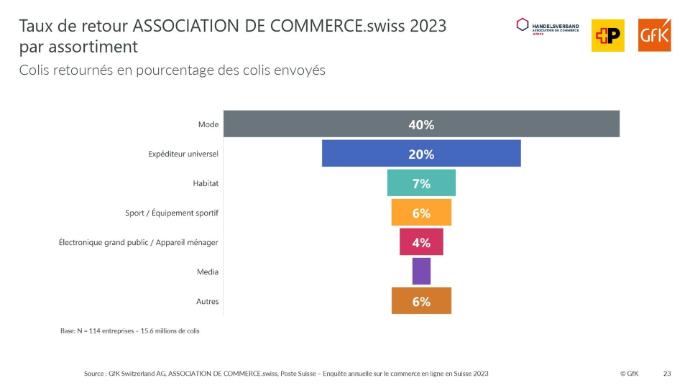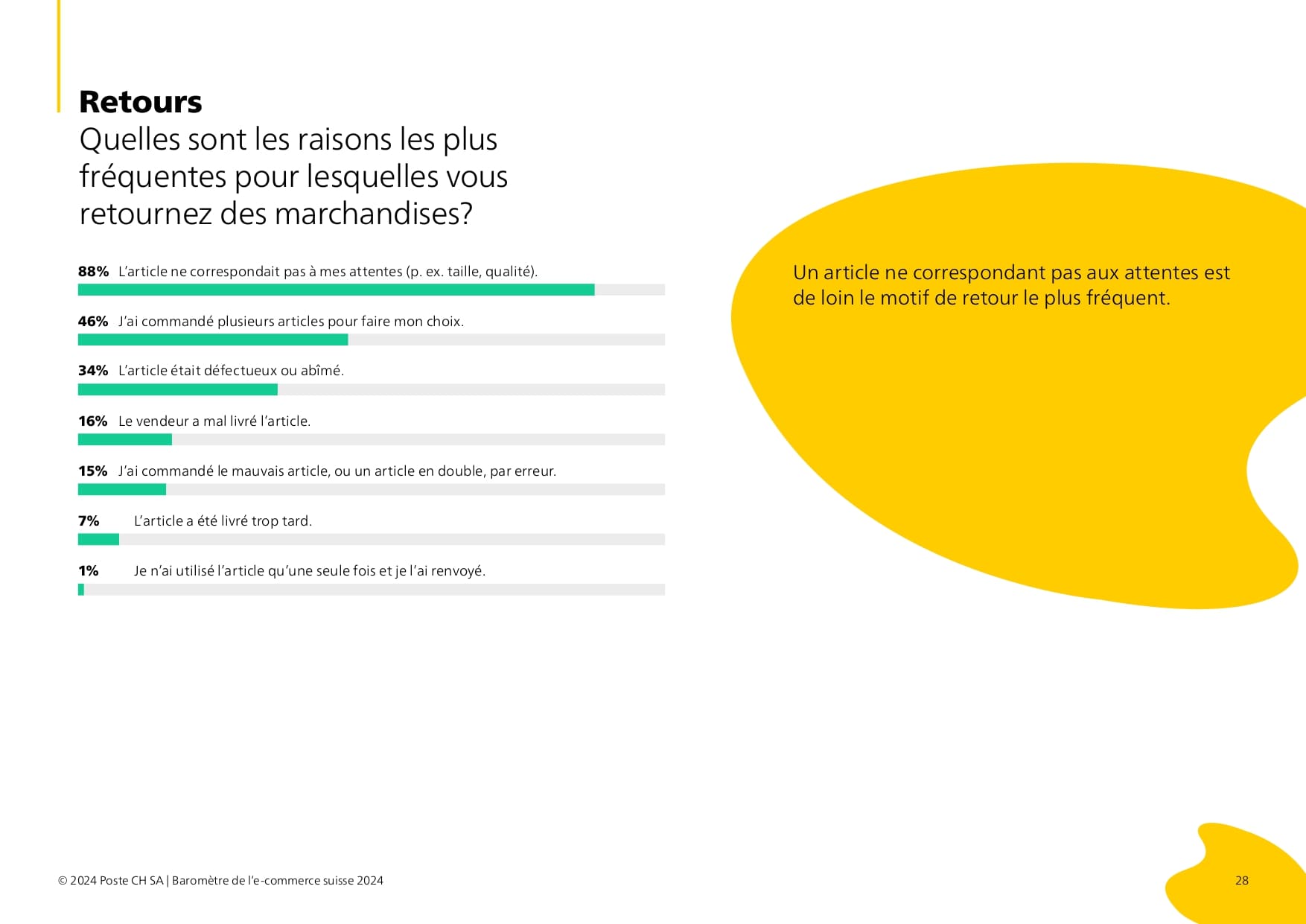Returns are a real problem in e-commerce. And the return rate in Switzerland is the highest in Europe (along with Germany), with approximately 27% of packages returned compared to 12% in Europe, generating a significant carbon impact. According to the ’Swiss Commerce Associationin 2023, the fashion sector will experience 40% returns, compared to 7% for the home goods sector, 6% for sports and sports equipment, and 4% for electronics. Zalando alone experiences 50% returns on all its sales (particularly in Germany). Blaming the problem on delivery is misleading and requires in-depth research. Although, I admit, implementing return logistics provides a solution for returns, it does little (or no) to explain why the customer returned their item or how to reduce its carbon impact. Infographic of the return rate in Switzerland in 2023

Source: handelsverband.swiss
Summary
Switzerland is a fan of parcel returns
In Switzerland, according to a DPD study, approximately 27% of parcels are returned, while the European average is 12%. How can this high return rate be explained? Several factors are possible:
Cultural preferences and consumer habits
Swiss consumers (and germans) have a strong tradition of online shopping. Accustomed to online shopping, they tend to appreciate the opportunity to try products before buying, particularly in the fashion sector. However, beauty products and utility products (hairdryers, shampoos, etc.) are less frequently returned, like most purchases.
A flexible return policy
Online retailers in Germany and Switzerland often offer generous return policies, allowing customers to easily return products that don't meet their expectations. In my opinion, competition between companies plays a role, as consumers are keen on free returns. This convenience encourages consumers to make purchases without obligation, knowing they can return items.
Business Practices for Returns
Some companies, particularly in the fashion industry, have integrated mass returns into their business model. For example, Zalando, a major online fashion retailer in Europe, reports that half of all orders are returned by customers.
The high return rates in Germany and Switzerland are the result of a combination of cultural factors, consumer habits, favorable business policies, and common practices in e-commerce. These elements reflect consumer expectations and company strategies in these specific markets. However, this only indirectly explains the number of returns. Because these can, and should, be reduced.
Causes of package returns
Let's start by identifying the causes of returned packages. The case of fashion, for example, is particularly relevant because there are many retailers, with many variations in sizes, colors, fabrics, etc. Conversely, electronics relies on a few factors, such as comfort fit, but is much more predictable.
Understanding why customers return their purchases is essential to addressing this. According to Swiss Post's 2024 Swiss E-commerce Barometer, the most common reasons include:
Items that are the wrong size or don't fit
This is by far the number one reason for e-commerce returns. According to Swiss Post's 2024 Swiss E-commerce Barometer, more than 88% of consumers cite a sizing issue (clothing too big/small, shoes not fitting) as the reason for a return. You also need to be able to choose between European and UK sizes if you live in Europe. A size "M" from one brand may correspond to a size 38 in another, or a size 40, depending on the fit and geographic area.
Ordering multiple items to make a choice
Approximately 46% of consumers order multiple items to be able to compare them and make a decision. This is a different consumer habit from serial returners, which I will discuss later.
Damaged or defective product
34% of returns are due to an item arriving broken, not working, or damaged. A poorly packaged package or rushed delivery can quickly cause damage.
Shipping error / Wrong product received
Receiving an incorrect reference or an item different from the one ordered logically leads to a return (the cause of 16% of returns). Warehouse malfunctions (picking errors, labeling errors) can be the cause.
Customer error
Sometimes a customer makes a mistake (15%) or orders the same item twice.
Other reasons
Returning a package due to late arrival accounts for 7% of returns. A more marginal phenomenon, serial returners are people who buy several variations and keep only their favorite (bracketing). Others buy an item of clothing to wear it only once and then return it (wardrobing).

Source: La Poste's 2024 e-commerce barometer
Solutions to reduce returns
E-consumers want a simple return solution. So let's offer it to them! I strongly advise against going against this principle. Competition requires (with some nuances) easy returns, and many brands are innovative in this area. However, it's important to implement a strategy upfront to reduce the number of returns.
Research the causes
Identifying the causes of returns is probably what will yield the most benefits. Use a multiple-choice questionnaire when a return request is made. Properly track these order returns in your CRM or database. Then analyze your return statistics. Is this a problem due to the size choice, which didn't meet the customer's expectations, or is it a damaged item that's more of a logistics issue?
A more detailed description of your products
If your reason for return is size, check if certain textiles or brands are more affected than others. There are differences between certain manufacturers and origins (the sizes of Italian women's brands are slightly larger than those of French brands, for example). If you have a large number of items, it's important to organize yourself properly. For example, offer a size guide that's closer together (38, 39, 40 instead of 38-40) depending on the textiles. In other sectors, add specifications that your customers often request. If your items are sold on Google Shopping, take advantage of A/B testing. Don't hesitate to implement your improvements little by little.
Your product images
Do your images accurately reflect your items? Is the photo taken too close, is there enough light, can the dimensions be clearly distinguished? In fashion, prefer people closer to your customers than professional models. They will be more easily identified with your brand.
Customer Recommendations
A detailed source for your items is your customer recommendations, if you have any in your store. Regularly import reviews, comments, and advice from customers. If you have many returns for an item, you may find your answer there. If you use social media, observe the comments. If part of your social media is UGC (User Generated Content), you probably have a wealth of information.
A damaged parcel return top
Talk to your carriers. I doubt the logistics provider is responsible, as the package is checked by the carrier before being accepted. Furthermore, the carrier is legally responsible for declaring a package damaged. Come to an agreement, but first check which carriers your customers prefer before changing. If you require additional verification before shipping, ask your logistics provider; they may offer more robust packaging solutions.
Errors during order preparation
If your orders are in warehouses, they are scanned before being packed. In principle, there should be no errors. However, with many packages and pickers at the same time, item mix-ups can occur. Human error is always possible.
The economic and environmental impact of returns for e-retailers
Carbon emissions from transport
The CO2 emissions associated with returning packages represent a significant environmental impact. However, it is important to consider the reduction in carbon emissions from individual transport when shopping in stores compared to online. Nevertheless, returns alone generate approximately 16 million tons of CO2 each year in the United States. Indirectly, these logistics costs represent a loss of revenue for e-retailers, but also for logistics providers. This cost is generally reflected in the price of the items and/or the potential return.
Waste Management and Overconsumption of Packaging
Some returned items are not returned to stock for various reasons and end up in landfills. Damaged or defective items may be discarded because recirculation and storage costs are too high. Furthermore, the packaging (which represents a significant transportation cost) is difficult to reuse, as are the adhesive tape, labels, etc.
Return Logistics
The numerous trips between sorting centers, the main warehouse, and possibly the return to the supplier add additional complexity, along with its associated CO2 emissions. Transportation, energy consumption, and labor costs before the item is put back on sale add economic and environmental complexity specific to e-commerce and its return logistics.
Returns: an opportunity for your business
Can returns be an opportunity to improve your product sales? Improving selection, better understanding customer tastes, and ensuring better delivery make you more competitive in many ways. Take advantage of returns management to develop a better understanding of your customers and your processes. Your customers will be happier, and so will you!
How to reduce e-commerce returns?